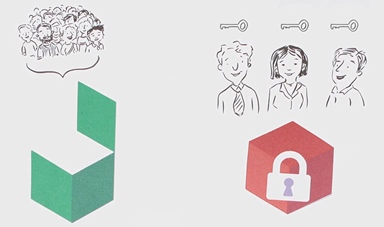Loading component...
At a glance
At its core, blockchain is a distributed ledger that records transactions between every user in the chain. Although it’s commonly regarded as a single technology, there are different types of blockchain: public and private.
The best-known public blockchains are the cryptocurrency ones such as that used for bitcoin transactions. They are completely transparent.
This type of platform is not going to suit organisations dealing with sensitive information such as commercial contracts or individuals’ personal information.
Private organisations are more likely to join a private blockchain, which allows invited users to transact without making data public.
Private blockchains allow different levels of permissions for users, so access can be restricted, and information can be encrypted to protect confidentiality.
Blockchain technology can be adapted to users’ needs.
This explainer video is an introduction to private and public blockchains.
WATCH NOW: What's the difference between a private and public blockchain?
TRANSCRIPT
What’s the difference between a private and public blockchain?
Blockchain has potential applications in many industries, from accounting to agriculture. It’s essentially a distributed ledger, which records transactions between every user in the chain.
There are different types of blockchain: some are open and public and some are private and only accessible to people who are given permission to use them.
A public blockchain is an open network. Anyone can download the protocol and read, write or participate in the network.
A public blockchain is distributed and decentralised. Transactions are recorded as blocks and linked together to form a chain. Each new block must be timestamped and validated by all the computers connected to the network, known as nodes, before it is written into the blockchain.
All transactions are public, and all nodes are equal. This means a public blockchain is immutable: once verified, data cannot be altered.
The best-known public blockchains used for cryptocurrency are Bitcoin and Ethereum: open-source, smart contract blockchains.
A private blockchain is an invitation-only network governed by a single entity.
Entrants to the network require permission to read, write or audit the blockchain. There can be different levels of access and information can be encrypted to protect commercial confidentiality.
Private blockchains allow organisations to employ distributed ledger technology without making data public.
But this means they lack a defining feature of blockchains: decentralisation. Some critics claim private blockchains are not blockchains at all, but centralised databases that use distributed ledger technology.
Private blockchains are faster, more efficient and more cost-effective than public blockchains, which require a lot of time and energy to validate transactions.
How secure are blockchains?
A private blockchain controls users’ access to information but is less secure than a public blockchain.
A public blockchain is a totally transparent ledger. Because it is decentralised, information is encrypted and stored on multiple devices. That makes it almost impossible to hack a public blockchain. The more members a blockchain has, the more secure it is.
Public blockchains are often called ‘censor-free’ and are particularly resistant to distributed denial-of-service – DDoS – attacks.
A private blockchain, on the other hand, can be altered by its owner. It’s also more vulnerable to hacking.
So how might accountants use blockchains?
Private blockchains could signal the end of double-entry bookkeeping.
Accountants will be able to use a private blockchain to automate auditing processes and audit transactions in real time.
Blockchain is forecast to disrupt the finance sector – but it could provide opportunities for accountants to invest more time in tasks that add value to their clients’ businesses.
These are early days for blockchain, but it has the potential to transform the world of finance, accounting and business.

